![]()
The Messe solennelle (1827)
The Requiem (1846, 1850, 1852)
The Te Deum (1855)
Église Saint-Eustache in pictures
This page is also available in French
This monumental church, near the Forum des Halles, was built between 1532 and 1637. It provided an ideal setting for the performance of large-scale choral works, and it is appropriate that over a period of nearly thirty years three of Berlioz’s major choral compositions, his Messe solennelle, Requiem, and Te Deum were performed there, all of them under his direction.
Berlioz’s early Messe solennelle, the first major work to bring him to public attention, had received its first performance in 1825 at the church of Saint-Roch. Two years later, on 22 November 1827, it was performed again, this time in the larger setting of Saint-Eustache and under the composer’s own direction; preparations for this performance had been underway since at least October (cf. CG no. 76bis [in vol. VIII]). Berlioz refers to the event in his Memoirs (chapter 8; an earlier version of this chapter appeared in November 1858 in Le Monde Illustré); he gives there a detached assessment of his own conducting as well as of the work itself, though he does not make clear that it was in fact the first time that he was appearing as a conductor (the first performance had been under the direction of Valentino, the conductor at the Opéra; Berlioz himself played the tam-tam, CG no. 48). Nor does he reveal that the performance took place at a time of great personal stress: two months earlier he had witnessed performances of Shakespeare’s Hamlet and Romeo and Juliet at the Odéon theatre, with Harriet Smithson as Ophelia then Juliet, and this was to change his life for ever. A letter written not long after the performance of the Messe solennelle to his friend Humbert Ferrand gives a detailed contemporary account of the occasion (CG no. 77 [in vol. VIII], 29 November):
[…] My Mass was performed on St Cecilia’s day with twice as much success as first time round; the small corrections I had introduced made a significant improvement to the work; in particular the piece Et iterum venturus, which had fallen flat at the first performance, was performed this time in an electrifying way, by six trumpets, four horns, three trombones and two ophicleids. The passage which follows for the chorus, which I made all the voices sing in unison

with an outburst of brass in the middle, made a terrific impression on everyone. For my part, I had managed to remain fairly calm up to that point, and it was important for me to keep my composure, as I was conducting. But when I witnessed this depiction of the Last Judgment, announced by six bass singers in unison, this tremendous clangor tubarum, these shouts of terror by the multitude represented by the chorus, and in short everything rendered exactly as I had conceived it, I was seized with a convulsive shaking which I had the strength to control until the end of the piece. But I was forced to sit down and allow my orchestra to rest for a few minutes; I could no longer stand up, and was worried the baton would fall from my hands. If only you had been there! I had a magnificent orchestra, I had invited 45 violins, 32 came, together with 8 violas, 10 cellos and 11 double-basses; unfortunately I did not have enough voices, particularly for an immense church like Saint-Eustache. […]
I was heard at a very inconvenient time; many people I had invited, including the Lesueur ladies, did not come because of the dreadful disturbances that had been taking place for several days in the Saint-Denis quarter. A. Berlioz was not there and only arrived the day before yesterday from a small trip in the vicinity of Auxerre to visit one of his relatives. All the same I have succeeded beyond my hopes; I really have a band of supporters at the Odéon, at the Bouffes, at the Conservatoire and at the Gymnase. Congratulations came in from every quarter; the evening of the performance I received a letter of compliments from a gentleman I do not know and who wrote to me some very nice things. I had sent letters of invitation to all the members of the Institut and was very glad to let them hear a performance of music which they describe as unperformable; my Mass is indeed thirty times more difficult than my competition cantata. You know that I have been forced to withdraw because M. Rifaut was unable to perform me on the piano, and that M. Berton wasted no time in declaring me to be unperformable, even by an orchestra. […]
The reference is to the cantata La Mort d’Orphée which Berlioz had composed the previous summer for the Prix de Rome competition. As for the Mass, Berlioz eventually became dissatisfied with it (his discovery of the music of Beethoven a few months later may have contributed to this reassessment); he discarded the work but re-used some of the music in other compositions, and in particular the Requiem and the Te Deum: the early Messe solennelle was thus a precursor of these two works of his maturity.
Berlioz’s monumental Requiem (the Grande messe des morts) received in all only five complete performances in the composer’s lifetime, all of them in Paris except for an enterprising performance in St Petersburg under Heinrich Romberg in 1841. The first performance of the work took place at Les Invalides in 1837 under the direction of Habeneck; all three subsequent performances were conducted by Berlioz himself and had as setting the monumental church of Saint-Eustache. In all three cases the performances were organised for a special commemorative purpose.
The performance of 20 August 1846 was in honour of the memory of Gluck (cf. CG nos. 1050, 1055, 1056, 1056bis [vol. VIII] on the preparations for the event). Two accounts of the occasion are extant in the composer’s correspondence; the first is to Dr Ambros in Prague, which Berlioz had recently visited (CG no. 1057, 21 August):
[…] I am still worn out by our great business of yesterday. This refers to my Requiem which we performed in the church of Saint-Eustache for a funeral ceremony in memory of Gluck, organised by the Association of Musicians of Paris. We were nearly five hundred performers; everything went magnificently, apart from a few small mistakes, and we had only done one orchestral rehearsal. I can assure you that it made a great impression. People duly wept and shivered. I would have loved to see you there, my dear Ambros, you and your friends in Prague. When can I come and let you hear this score in the Spanish Hall of the Archduke’s Palace, with the assistance of our excellent Kittl?… […]

I keep coming back to the Requiem; all these sinister harmonies are wailing in my head, I feel I have witnessed a scene from the Apocalypse, I hear nothing but shouts of terror, rumbles of thunder, the noise of worlds crumbling before this clangor tubarum. Forgive me for being preoccupied in this way. […]
The second account is to his father a few weeks later (CG no. 1060, 16 September):
[…] You must have heard about the performance of my Requiem at a ceremony in honour of Gluck, organised last month by the Association of Musicians of Paris. My work was incomparably more effective than first time round at the Invalides. We were 500 performers, and I was conducting; the acoustic of Saint-Eustache is excellent, everyone was showing commitment and there was a huge crowd in the audience. The impression made by the Dies Irae was truly extraordinary, particularly at the verse Judex ergo cum sedebit. The president of the Association of Musicians, Baron Taylor, gave me warm support in overcoming the obstacles which two or three of my good enemies wanted to put in our way to prevent this performance. […]
Less is known about the second performance at Saint-Eustache, on 3 May 1850, held in support of the families of victims killed by the collapse of a bridge at Angers. The concert was given with the orchestra and chorus of the Société Philharmonique which Berlioz had founded earlier in the year (further details on the performance are provided in that page). Berlioz’s letters give information on the preparations for the concert (CG nos. 1321-4, 1325, and [vol. VIII] 1322bis, 1322ter, 1327bis), but no account of the performance has survived from his pen; the reason is probably that it came the day before the death of his sister Nancy after a long illness. As he writes to his other sister Adèle, ‘Fate willed that the day before our sister died I was busy at St Eustache with the performance of my Requiem. Is that not a sad and strange coincidence?…’ (CG no. 1331, 15 May).
The third perfomance, on 22 October 1852, seems to have been the grandest of all those given in Paris, and it attracted a large and distinguished audience. It was held in honour of a wealthy patron of the arts, Baron de Trémont, who had bequeathed his entire fortune to associations of musicians, and many of whom insisted in taking part in the performance (cf. CG nos. 1509-10, 1514-15, 1517-18, 1520-2). Two accounts of the event by Berlioz survive in his correspondence, the first to his sister Adèle (CG no. 1524, 25 October):
[…] I have been feeling rather uncomfortable since Friday, as a result of the emotions aroused by the Requiem. You have never missed such an opportunity to hear my work. It was colossal! We were nearly 600, I had an amphitheatre constructed in the choir to raise my choristers, and the effect was all the better. The whole of elegant Paris was present, the Institut was there, as were the famous artists in every genre, and a dense crowd. I had the satisfaction of seeing many people weep. The day before this ceremony the director of the Opéra tried to prevent all the personnel of his theatre from participating, and Baron Taylor, our president, tried in vain to make him reverse this stupid decision taken purely against me. I then informed the minister of the Interior who immediately sent to the honourable Roqueplan an order to display at the Opéra a notice intimating that the ban had been lifted. This rebuff administered to this gentleman gave added spice to the success I scored the day after. Besides, all the artists were determined to come in spite of the ban. This is causing a great stir. This funeral mass was being celebrated for the peace of Baron de Trémont’s soul; he has just bequeathed his entire fortune to the artists.
I am very sorry that none of you were present; it was one of these solemn artistic occasions which only happen twice or thrice in a lifetime. […]
The second account, to Liszt, is briefer (CG no. 1525, 29 October):
[…] The performance of the Requiem was grandiose if not delicate, and never since I have written this score has it made such an impact. How I would have like to let you hear it. As is usual, whenever I commit some ENORMITY in Paris the Journal des Débats did not say a word about it… but the impression made on the immense audience thronging the church of Saint-Eustache was profound and a blow has been struck. […]
Despite what Berlioz says in this letter, the Journal des Débats went on to make handsome amends: on 23 November it published a long and enthusiastic review of the performance, written by J.-E. Duchesne, a friend and admirer of Berlioz. In a letter to his sister Adèle, late in November, Berlioz described the review as ‘the finest analysis that has yet been written of my Requiem’ (CG no. 1537). The review is reproduced in full on this site.
Though originally written in 1848-9 in circumstances and for motives that remain unclear, the Te Deum had to wait years before it could receive its first performance, at Saint-Eustache on 30 April 1855, under the direction of the composer, in the year of the great Universal Exhibition in Paris; this was to be the only complete performance of the work in Berlioz’s lifetime. Berlioz thought of the Te Deum as a ‘brother’ of the earlier Requiem (CG nos. 1959, 1961). The scoring of the two works is on a lavish scale, the style similarly monumental, and they both include a part for solo tenor; the Te Deum differs from the earlier work in using an organ in addition to the orchestra. But the organ is used not to augment the sonority of the orchestra but rather to contrast with it. Organ and orchestra, as Berlioz put it, should be like ‘Pope and Emperor, speaking in dialogue from opposite ends of the nave’ (cf. CG no. 1111). In a letter to Liszt, dated 1 January 1853, Berlioz, talking about the Te Deum, writes: ‘the organ does not accompany, but rather enters into dialogue with the orchestra’ (CG no. 1552). He also makes similar comments in the organ section of his Treatise on orchestration and instrumentation to explain the different roles of the orchestra and the organ: ‘The organ and the orchestra are both Kings, or rather one is Emperor and the other Pope; they have different missions, their interests are too vast and too divergent to be confused.’
Several letters of Berlioz describe the performance at Saint-Eustache, the grandest musical event that Berlioz ever put on in that church; the earliest, addressed to Liszt, was written on the day of the performance (CG no. 1959), another one, to Auguste Morel in Marseille, came several weeks later (CG no. 1972, 2 June), and there is also a letter to his sister Adèle only a few days after the event (CG no. 1961, 4 May):
I did not write to you on the day of our great business at Saint-Eustache nor the day after; I was too tired and exhausted. I thought I was about to fall seriously ill.
Today I am better. Let me therefore tell you that this enormous ceremony, which attracted an immense crowd, has also made the most immense impression. There was a moment of emotion so great that in one corner of the church applause broke out, though it was quickly suppressed. It was colossal, I assure you; I now know that my Requiem has a brother (the Te Deum) and a brother that is worthy of him.
I cannot describe to you the sight of this vast cathedral, so magnificently decked out at the moment, with my orchestra filling the choir, my choristers the cross of the nave, and these 800 children on a vast amphitheatre which rose up to a height of two storeys.
Neither can I say anything to you about the majesty of this immense duet between us and the organ that was singing mysteriously at the other end of the church.
These are things that need to be seen and heard… M. Lecourt, an erudite and devoted music-lover who had come from Marseille specially, was drenched with tears after the last movement, and he was not the only one. When it was all over I stood there surrounded by a crowd, unable to leave my place, and had it not been for the sanctity of the place I believe I would have been crushed in embraces. […]
Farewell, dear sister, I am in a state of calm contentment, born of the joy of having created something novel which is thought to be beautiful; at any rate the work is of a grandeur that is out of scale, as is without doubt the effect it produced. […]
See also the review of the performance published shortly after by Edmond Viel in Le Ménestrel.
![]()
All the modern photographs reproduced on this page were taken by Michel Austin in 2002; the 19th century engravings and the postcard are from our collection. © Monir Tayeb and Michel Austin. All rights of reproduction reserved.
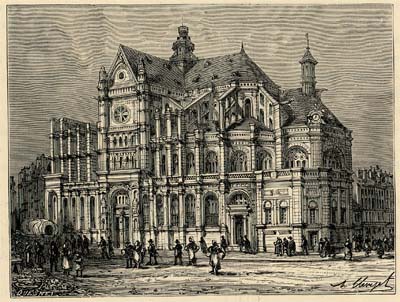
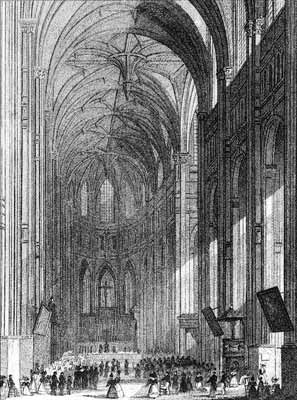
This is an 1830 engraving showing the nave, scanned from A. Pugin’s book Paris and its Environs, published in London in 1831, in our collection.
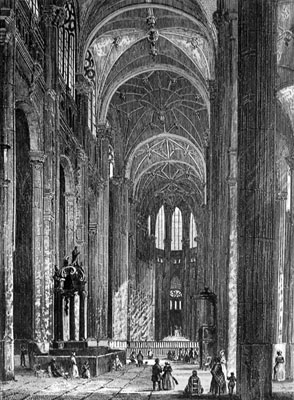
The above engraving was published in a book entitled Les Églises de Paris (Paris, 1843), a copy of which is in our collection.
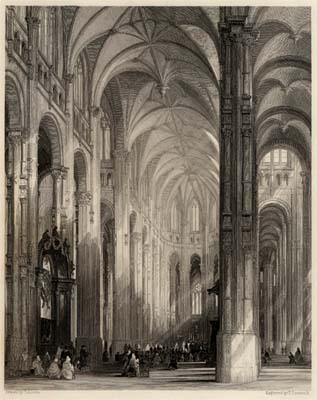
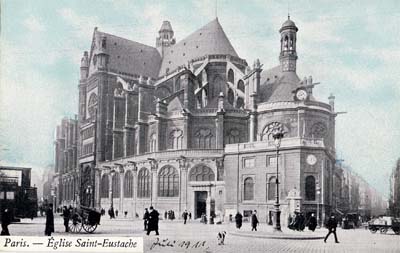
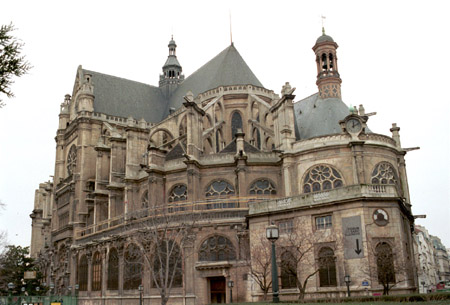
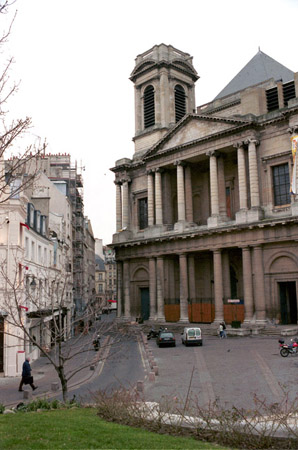
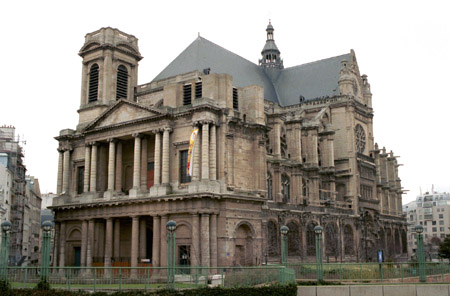
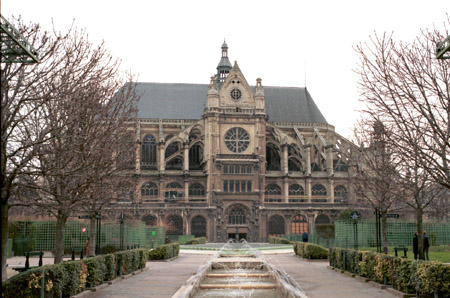
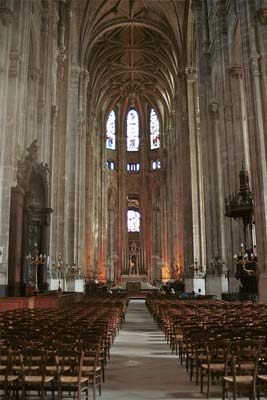
At the première of the Te Deum the orchestra, ‘the Emperor’, and the choruses were placed at the altar end of the nave.
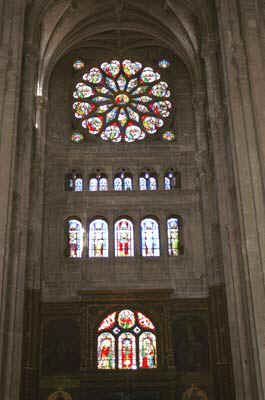
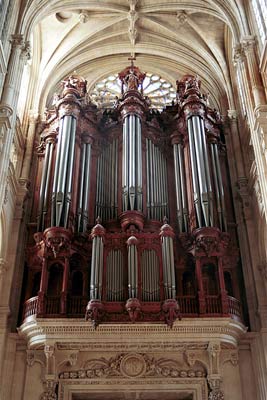
This is the organ, ‘the Pope’, which entered into dialogue with Berlioz’s orchestra at the première of the Te Deum.
![]()
© Monir Tayeb and Michel Austin for all the pictures and information on this page.
Copyright notice: The texts, photos, images and musical scores on all pages of this site are covered by UK Law and International Law. All rights of publication or reproduction of this material in any form, including Web page use, are reserved. Their use without our explicit permission is illegal.